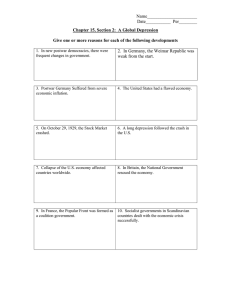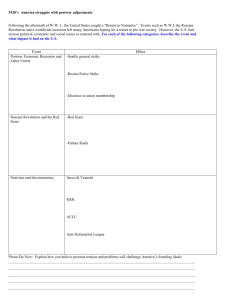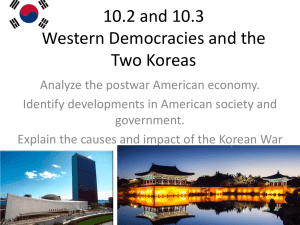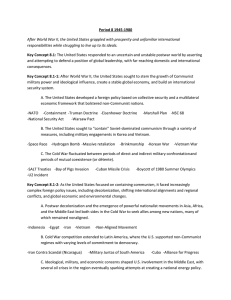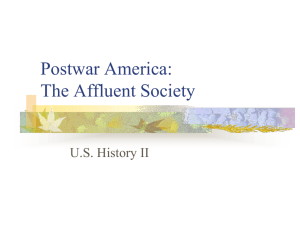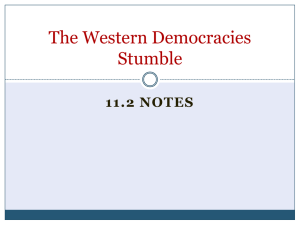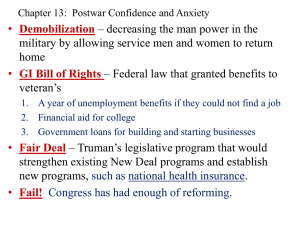PERIOD 8: 1945–1980
advertisement
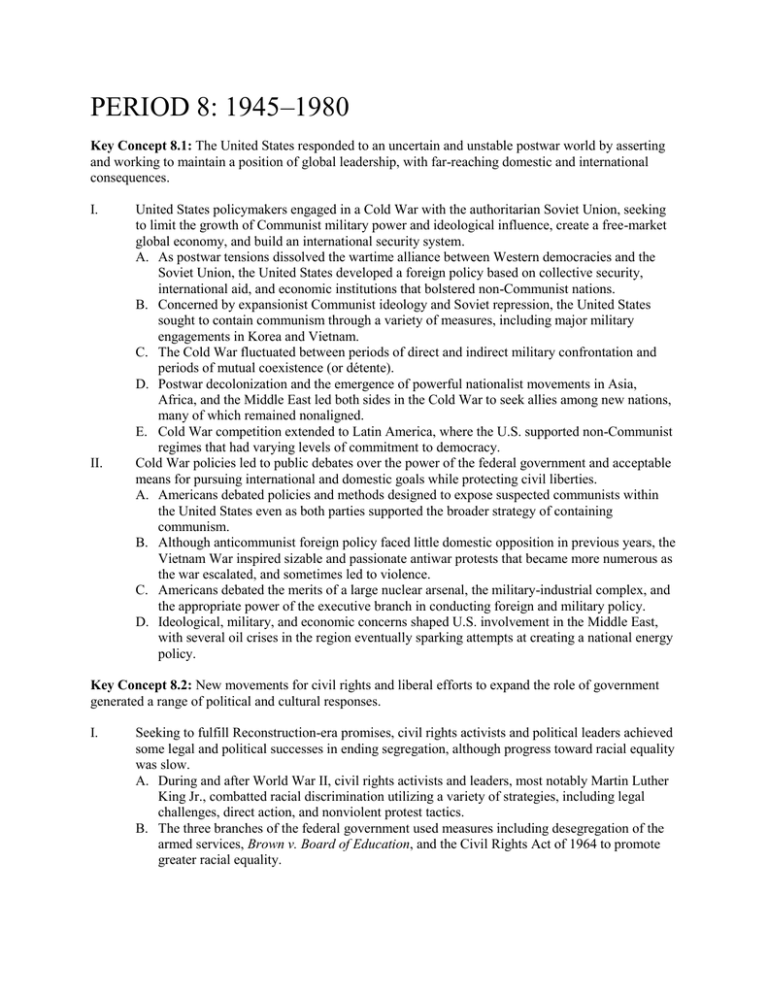
PERIOD 8: 1945–1980 Key Concept 8.1: The United States responded to an uncertain and unstable postwar world by asserting and working to maintain a position of global leadership, with far-reaching domestic and international consequences. I. II. United States policymakers engaged in a Cold War with the authoritarian Soviet Union, seeking to limit the growth of Communist military power and ideological influence, create a free-market global economy, and build an international security system. A. As postwar tensions dissolved the wartime alliance between Western democracies and the Soviet Union, the United States developed a foreign policy based on collective security, international aid, and economic institutions that bolstered non-Communist nations. B. Concerned by expansionist Communist ideology and Soviet repression, the United States sought to contain communism through a variety of measures, including major military engagements in Korea and Vietnam. C. The Cold War fluctuated between periods of direct and indirect military confrontation and periods of mutual coexistence (or détente). D. Postwar decolonization and the emergence of powerful nationalist movements in Asia, Africa, and the Middle East led both sides in the Cold War to seek allies among new nations, many of which remained nonaligned. E. Cold War competition extended to Latin America, where the U.S. supported non-Communist regimes that had varying levels of commitment to democracy. Cold War policies led to public debates over the power of the federal government and acceptable means for pursuing international and domestic goals while protecting civil liberties. A. Americans debated policies and methods designed to expose suspected communists within the United States even as both parties supported the broader strategy of containing communism. B. Although anticommunist foreign policy faced little domestic opposition in previous years, the Vietnam War inspired sizable and passionate antiwar protests that became more numerous as the war escalated, and sometimes led to violence. C. Americans debated the merits of a large nuclear arsenal, the military-industrial complex, and the appropriate power of the executive branch in conducting foreign and military policy. D. Ideological, military, and economic concerns shaped U.S. involvement in the Middle East, with several oil crises in the region eventually sparking attempts at creating a national energy policy. Key Concept 8.2: New movements for civil rights and liberal efforts to expand the role of government generated a range of political and cultural responses. I. Seeking to fulfill Reconstruction-era promises, civil rights activists and political leaders achieved some legal and political successes in ending segregation, although progress toward racial equality was slow. A. During and after World War II, civil rights activists and leaders, most notably Martin Luther King Jr., combatted racial discrimination utilizing a variety of strategies, including legal challenges, direct action, and nonviolent protest tactics. B. The three branches of the federal government used measures including desegregation of the armed services, Brown v. Board of Education, and the Civil Rights Act of 1964 to promote greater racial equality. C. Continuing resistance slowed efforts at desegregation, sparking social and political unrest across the nation. Debates among civil rights activists over the efficacy of nonviolence increased after 1965. Responding to social conditions and the African American civil rights movement, a variety of movements emerged that focused on issues of identity, social justice, and the environment. A. Feminist and gay and lesbian activists mobilized behind claims for legal, economic, and social equality. B. Latino, American Indian, and Asian American movements continued to demand social and economic equality and a redress of past injustices. C. Despite an overall affluence in postwar America, advocates raised concerns about the prevalence and persistence of poverty as a national problem. D. Environmental problems and accidents led to a growing environmental movement that aimed to use legislative and public efforts to combat pollution and protect natural resources. The federal government established new environmental programs and regulations. Liberalism influenced postwar politics and court decisions, but it came under increasing attack from the left as well as from a resurgent conservative movement. A. Liberalism, based on anticommunism abroad and a firm belief in the efficacy of government power to achieve social goals at home, reached a high point of political influence by the mid1960s. B. Liberal ideas found expression in Lyndon Johnson’s Great Society, which attempted to use federal legislation and programs to end racial discrimination, eliminate poverty, and address other social issues. A series of Supreme Court decisions expanded civil rights and individual liberties. C. In the 1960s, conservatives challenged liberal laws and court decisions and perceived moral and cultural decline, seeking to limit the role of the federal government and enact more assertive foreign policies. D. Some groups on the left also rejected liberal policies, arguing that political leaders did too little to transform the racial and economic status quo at home and pursued immoral policies abroad. E. Public confidence and trust in government’s ability to solve social and economic problems declined in the 1970s in the wake of economic challenges, political scandals, and foreign policy crises. F. The 1970s saw growing clashes between conservatives and liberals over social and cultural issues, the power of the federal government, race, and movements for greater individual rights. II. III. Key Concept 8.3: Postwar economic and demographic changes had far-reaching consequences for American society, politics, and culture. I. Rapid economic and social changes in American society fostered a sense of optimism in the postwar years. A. A burgeoning private sector, federal spending, the baby boom, and technological developments helped spur economic growth. B. As higher education opportunities and new technologies rapidly expanded, increasing social mobility encouraged the migration of the middle class to the suburbs and of many Americans to the South and West. The Sun Belt region emerged as a significant political and economic force. C. Immigrants from around the world sought access to the political, social, and economic opportunities in the United States, especially after the passage of new immigration laws in 1965. II. New demographic and social developments, along with anxieties over the Cold War, changed U.S. culture and led to significant political and moral debates that sharply divided the nation. A. Mass culture became increasingly homogeneous in the postwar years, inspiring challenges to conformity by artists, intellectuals, and rebellious youth. B. Feminists and young people who participated in the counterculture of the 1960s rejected many of the social, economic, and political values of their parents’ generation, introduced greater informality into U.S. culture, and advocated changes in sexual norms. C. The rapid and substantial growth of evangelical Christian churches and organizations was accompanied by greater political and social activism on the part of religious conservatives.
